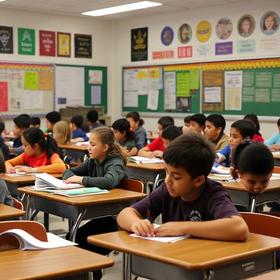Harry D. Daniels School serves 257 students in grades Kindergarten-4.
The student-teacher ratio of 11:1 was equal to the New York state level of 11:1.
School Overview
Grades Offered
Grades Kindergarten-4
Total Students
257 students
Total Classroom Teachers
23 teachers
School Rankings
Student-Teacher Ratio
11:1
11:1
American Indian
n/a
1%
Asian
n/a
10%
Hispanic
23%
30%
Black
77%
16%
White
n/a
40%
Hawaiian
n/a
n/a
Two or more races
n/a
3%
All Ethnic Groups
Eligible for Free Lunch
37%
54%
Eligible for Reduced Lunch
30%
3%
School Statewide Testing
School District Name
Source: National Center for Education Statistics (NCES), NY Dept. of Education
Frequently Asked Questions
How many students attend Harry D. Daniels School?
257 students attend Harry D. Daniels School.
What is the racial composition of the student body?
77% of Harry D. Daniels School students are Black, and 23% of students are Hispanic.
What is the student-teacher ratio of Harry D. Daniels School?
Harry D. Daniels School has a student ration of 11:1, which is equal to the New York state average of 11:1.
What grades does Harry D. Daniels School offer ?
Harry D. Daniels School offers enrollment in grades Kindergarten-4
What school district is Harry D. Daniels School part of?
Harry D. Daniels School is part of Roosevelt Union Free School District.
Recent Articles

How Public Schools Support Students on Free / Reduced-Lunch Programs
Explore how U.S. public schools support students eligible for free or reduced-price lunch through nutrition, academic, and wraparound services in 2025.

Hidden Costs of Public Schools: Fees, Supplies & Extras
Explore the hidden costs in public schools—fees, supplies, extracurriculars—and how parents can plan for them in 2025.

Public School Funding 2025: What Families Should Know
Essential insights on public school funding in 2025—how it works, what’s changing, and what families should know to stay ahead.





